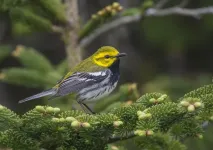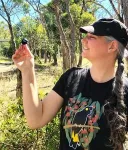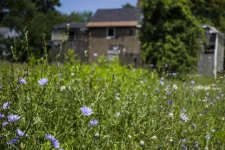(Press-News.org) UNIVERSITY PARK, Pa. — A spat between birds at your backyard birdfeeder highlights the sometimes fierce competition for resources that animals face in the natural world, but some ecologically similar species appear to coexist peacefully. A classic study in songbirds by Robert MacArthur, one of the founders of modern ecology, suggested that similar wood warblers — insect-eating, colorful forest songbirds — can live in the same trees because they actually occupy slightly different locations in the tree and presumably eat different insects. Now, a new study is using modern techniques to revisit MacArthur’s observations, which are still used as an example in today’s biology textbooks.
Led by researchers at Penn State and the American Bird Conservancy, the new project suggests that how these songbirds coexist is more nuanced than MacArthur originally proposed. The study, which examined foraging behavior, physical characteristics, diet and evolutionary history of warblers, appeared today (April 16) in the journal Biology Letters.
A basic principle in the field of ecology describes how two species that compete for the same basic resources, such as food or habitat, cannot coexist indefinitely in the same area. One of the species will ultimately be more successful and replace the other. In his landmark paper from 1958, MacArthur described how five species of wood warbler that live in the same trees and were thought to be “ecologically equivalent” could actually coexist by foraging in different parts of the same tree. For example, some birds foraged near the trunk and others further out in the branches, while some birds foraged near the top of other tree and others at the bottom.
“MacArthur suggested that we needed to look more closely at species interactions,” said David Toews, Louis Martarano Career Development Professor of Biology in the Penn State Eberly College of Science and an author of the paper. “We wanted to revisit this idea with modern technology, using molecular methods and an evolutionary perspective that weren’t available in MacArthur’s time. This allowed us to not only directly quantify their diet, but also better understand how warblers are partitioning their habitat and how what we see today may have been shaped by competition over the warbler’s evolutionary history.”
The research team studied 13 species of wood warblers that coexist in the forests of northeastern New York, where the birds breed in the summer. They observed foraging behaviors of birds over 20 years, for example collecting information about the birds’ height in a tree, the density of foliage, and distance from the trunk when eating. They also collected fecal samples over five summers to assess the content of the bird’s diet, which comprises insects and spiders. Additionally, the researchers sourced measurements about each species’ physical characteristics as well as their beaks from two public databases.
“The implication from MacArthur’s study is that, if the birds are foraging in different areas of the tree, then they are eating different things,” Toews said. “MacArthur tried to test this using data from his colleagues, who attempted to analyze fragments of insects from stomach contents, but this was biased toward fragments that weren’t digested, and they were extremely difficult to identify. Now, we can extract DNA from fecal samples and use a technique called fecal meta-barcoding to see which insect species have been eaten by birds.”
The researchers, like MacArthur, found that the foraging behaviors of the birds are strongly different among species.
“A bird’s size and shape are products of many pressures operating over evolutionary timescales, but numerous studies, including our own, show that chief amongst these pressures is foraging behavior,” said Eliot Miller, BirdsPlus Index Manager at the American Bird Conservancy and an author of the paper.
Accordingly, the researchers found that differences in foraging were linked to the birds’ physical characteristics. For example, smaller birds tended to hover more often while foraging, and birds with longer leg bones tended to forage near the ground. Differences in diet, however, were minor.
“The birds we studied collectively consumed thousands of arthropod species, and there was a considerable amount of overlap in their diets,” Toews said. “The differences in diet were quite subtle, and we found that closely related species had more similar diets. This suggests that MacArthur’s emphasis on diet may have been partially misplaced, though the general idea of portioning their resources by foraging in different parts of the trees is sound.”
Toews said that the birds appeared to be opportunistic in their foraging. More than 75% of fecal samples contained the most common insect in the area, a snipefly, and more than half of the samples contained a common, invasive leaf weevil.
“Because of the notable differences in foraging behavior, we believe that competition has shaped how these species forage today, as well as how they evolved to forage over evolutionary time,” Miller said. “But we don’t see many differences in diet, so it’s likely that other forces may have more directly influenced warbler evolution. It is worth noting that these birds migrate to Central and South America over the winter, so competition for resources in those locations as well as the stress of migration may also shape the traits we see today.”
The researchers said they hope to further investigate diet and foraging behavior of warblers in their overwintering locations. They also plan to analyze the nutritional quality of food sources to see if competition impacts this aspect of their diet.
“MacArthur was right in that these warblers are partitioning their habitat in fine ways, but it’s a little more complex than he originally thought,” Toews said. “People often observe competitive interactions between species at their bird feeders, and studies like this show how these kinds of interactions that happened hundreds or thousands of years ago can shape the species we see today.”
In addition to Toews and Miller, the research team at Penn State includes Andrew Wood, a research technologist in Toews’ lab at the time of the research who is now an environmental genomics researcher at the University of Minnesota, Duluth, and Marcella Baiz, a postdoctoral researcher in Toews’ lab at the time of the research who is now an assistant professor of biological sciences at the University at Buffalo. The team also includes Andreanna Welch at the Durham University in the United Kingdom, Robert Fleischer at the Smithsonian’s National Zoo and Conservation Biology Institute and Adrienne Dale at Texas Tech University.
Funding from the U.S. National Science foundation, Schmidt Sciences, the Cornell Lab of Ornithology, Penn State, the Penn State Eberly College of Science, and the Penn State Huck Institutes of the Life Sciences supported this work.
END
Foraging on the wing: How can ecologically similar birds live together?
New study uses modern molecular and evolutionary techniques to reassess a foundational, 67-year-old study in warblers
2025-04-16
ELSE PRESS RELEASES FROM THIS DATE:
Little birds’ personalities shine through their song – and may help find a mate
2025-04-16
In birds, singing behaviours play a critical role in mating and territory defence.
Although birdsong can signal individual quality and personality, very few studies have explored the relationship between individual personality and song complexity, and none has investigated this in females, say Flinders University animal behaviour experts.
They have examined the relationships between song complexity and two personality traits (exploration and aggressiveness) in wild superb fairy-wrens (Malurus cyaneus) in Australia, a species in which both sexes learn to produce complex songs.
“Regardless of their sex ...
Primate mothers display different bereavement response to humans
2025-04-16
Macaque mothers experience a short period of physical restlessness after the death of an infant, but do not show typical human signs of grief, such as lethargy and appetite loss, finds a new study by UCL anthropologists.
Published in Biology Letters, the researchers found that bereaved macaque mothers spent less time resting (sleep, restful posture, relaxing) than the non-bereaved females in the first two weeks after their infants’ deaths.
Researchers believe this physical restlessness could represent an initial period of ‘protest’ among the bereaved macaque mothers, similar ...
New pollen-replacing food for honey bees brings new hope for survival
2025-04-16
PULLMAN, Wash., -- Scientists have unveiled a new food source designed to sustain honey bee colonies indefinitely without natural pollen.
Published April 16 in the journal Proceedings of the Royal Society B, the research from Washington State University and APIX Biosciences NV in Wingene, Belgium details successful trials where nutritionally stressed colonies, deployed for commercial crop pollination in Washington state, thrived on the new food source.
This innovation, which resembles the man-made diets ...
Gene-based blood test for melanoma may catch early signs of cancer’s return
2025-04-15
Monitoring blood levels of DNA fragments shed by dying tumor cells may accurately predict skin cancer recurrence, a new study shows.
Led by researchers at NYU Langone Health and its Perlmutter Cancer Center, the study showed that approximately 80% of stage III melanoma patients who had detectable levels of circulating tumor DNA (ctDNA) before they started treatment to suppress their tumors went on to experience recurrence.
The researchers also found that the disease returned more than four times faster in this group than in those with no detectable levels of the biomarker, and the higher ...
Common genetic variants linked to drug-resistant epilepsy
2025-04-15
Certain common genetic changes might make some people with focal epilepsy less responsive to seizure medications, finds a new global study led by researchers at UCL and UTHealth Houston.
Focal epilepsy is a condition where seizures start in one part of the brain. It is the most common type of epilepsy.
Antiseizure medication is usually prescribed for people with the condition. However, for one in three people with epilepsy (around 20 million individuals worldwide), current antiseizure medications are ineffective. This means ...
Brisk walking pace + time spent at this speed may lower risk of heart rhythm abnormalities
2025-04-15
A brisk walking pace, and the amount of time spent at this speed, may lower the risk of heart rhythm abnormalities, such as atrial fibrillation, tachycardia (rapid heartbeat), and bradycardia (very slow heartbeat), finds research published online in the journal Heart.
The findings were independent of known cardiovascular risk factors, but strongest in women, the under 60s, those who weren’t obese, and those with pre-existing long term conditions.
Heart rhythm abnormalities (arrhythmias) are common, note the authors, with atrial fibrillation ...
Single mid-afternoon preventer inhaler dose may be best timing for asthma control
2025-04-15
A single daily preventer dose of inhaled corticosteroid (beclomethasone), taken mid afternoon, may be the best timing for effective asthma control as it suppresses the usual nocturnal worsening of symptoms more effectively than dosing regimens at other times of the day, suggest the results of a small clinical trial published in the journal Thorax.
If the findings are confirmed in larger studies, this approach may lead to better clinical outcomes for patients without increasing unwanted steroidal ...
Symptoms of ice cold feet + heaviness in legs strongly linked to varicose veins
2025-04-15
Hypersensitivity to the cold, especially ice cold feet, as well as a feeling of heaviness in the legs, are linked to the presence of varicose veins, finds a large study published in the open access journal Open Heart.
Cold hypersensitivity is often underestimated as a subjective symptom, say the researchers.
Varicose veins are usually caused by impaired functioning of the deep or superficial veins, and the perforator veins (short veins that link the superficial and deep venous systems in the legs).
The prevalence of varicose veins ranges from 2% to 30% in adults, with women at higher risk. And symptoms include sensations ...
Brain areas necessary for reasoning identified
2025-04-15
A team of researchers at UCL and UCLH have identified the key brain regions that are essential for logical thinking and problem solving.
The findings, published in Brain, help to increase our understanding of how the human brain supports our ability to comprehend, draw conclusions, and deal with new and novel problems – otherwise known as reasoning skills.
To determine which brain areas are necessary for a certain ability, researchers study patients with brain lesions (an area of damage in the brain) caused by stroke or brain tumours. This approach, known ...
Growing wildflowers on disused urban land can damage bee health
2025-04-15
Wildflowers growing on land previously used for buildings and factories can accumulate lead, arsenic and other metal contaminants from the soil, which are consumed by pollinators as they feed, a new study has found.
The metals have previously been shown to damage the health of pollinators, which ingest them in nectar as they feed, leading to reduced population sizes and death. Even low nectar metal levels can have long-term effects, by affecting bees’ learning and memory - which impacts their foraging ability.
Researchers have found that common plants including white clover and bindweed, which ...
LAST 30 PRESS RELEASES:
New prostate cancer trial seeks to reduce toxicity without sacrificing efficacy
Geometry shapes life
A CRISPR screen reveals many previously unrecognized genes required for brain development and a new neurodevelopmental disorder
Hot flush treatment has anti-breast cancer activity, study finds
Securing AI systems against growing cybersecurity threats
Longest observation of an active solar region
Why nail-biting, procrastination and other self-sabotaging behaviors are rooted in survival instincts
Regional variations in mechanical properties of porcine leptomeninges
Artificial empathy in therapy and healthcare: advancements in interpersonal interaction technologies
Why some brains switch gears more efficiently than others
UVA’s Jundong Li wins ICDM’S 2025 Tao Li Award for data mining, machine learning
UVA’s low-power, high-performance computer power player Mircea Stan earns National Academy of Inventors fellowship
Not playing by the rules: USU researcher explores filamentous algae dynamics in rivers
Do our body clocks influence our risk of dementia?
Anthropologists offer new evidence of bipedalism in long-debated fossil discovery
Safer receipt paper from wood
Dosage-sensitive genes suggest no whole-genome duplications in ancestral angiosperm
First ancient human herpesvirus genomes document their deep history with humans
Why Some Bacteria Survive Antibiotics and How to Stop Them - New study reveals that bacteria can survive antibiotic treatment through two fundamentally different “shutdown modes”
UCLA study links scar healing to dangerous placenta condition
CHANGE-seq-BE finds off-target changes in the genome from base editors
The Journal of Nuclear Medicine Ahead-of-Print Tip Sheet: January 2, 2026
Delayed or absent first dose of measles, mumps, and rubella vaccination
Trends in US preterm birth rates by household income and race and ethnicity
Study identifies potential biomarker linked to progression and brain inflammation in multiple sclerosis
Many mothers in Norway do not show up for postnatal check-ups
Researchers want to find out why quick clay is so unstable
Superradiant spins show teamwork at the quantum scale
Cleveland Clinic Research links tumor bacteria to immunotherapy resistance in head and neck cancer
First Editorial of 2026: Resisting AI slop
[Press-News.org] Foraging on the wing: How can ecologically similar birds live together?New study uses modern molecular and evolutionary techniques to reassess a foundational, 67-year-old study in warblers




